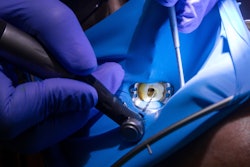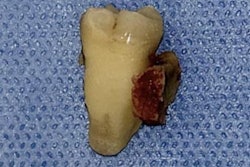
After being treated with temporary endodontic material containing polyethylene glycol (PEG), two patients experienced anaphylaxis, one of whom died, according to a case report published on September 13 in the Journal of Endodontics.
The case report not only sheds light on the possible harm that PEG can cause to some patients but that an allergy to this chemical should be explored in cases of anaphylaxis related to endodontic treatment, the authors wrote.
"Due to the risk of anaphylaxis the use of endodontic filling materials containing PEG is generally discouraged," wrote the authors, led by Dr. Marie Alnaes of Haukeland University Hospital in Norway.
A 50-year-old patient with no known allergies
The patient underwent endodontic treatment and a temporary root canal material was used. The procedure was completed without complications and the patient was in good condition when leaving the office. A few minutes later, the patient developed pronounced skin itching, and five minutes later, the patient reported feeling sick and vomited. The patient became unresponsive, and an ambulance was called.
When the ambulance arrived a few minutes later, the patient was unconscious and cyanotic. The patient's blood pressure was 119/91, they had a pulse of 26 bpm to 72 bpm, and an oxygen saturation level of 80%. There was swelling of the tongue, and the patient was intubated without medication, according to the report.
Upon arrival at the hospital, the patient was in cardiac arrest. Cardiopulmonary resuscitation was initiated and spontaneous circulation was restored. A computed tomography scan showed global hypoxic brain damage and a neurophysiological examination revealed the loss of cortical response.
When the patient arrived at the hospital, serum tryptase was measured at 158 μg/L (normal <12 μg/L), it dropped to 50 μg/L the next day. Total immunoglobulin E (IgE) was 147 kU/L (normal <120 kU/L). Specific IgE testing to chlorhexidine, gelatin (bovine), morphine, fentanyl, latex, and alpha-galactose-thyroglobulin were normal, the authors wrote.
The patient's death was deemed anaphylaxis related to PEG in the endodontic material. The diagnosis of anaphylaxis was certainly due to the considerable rise and fall of serum tryptase, they wrote.
A 30-year-old healthy man
A patient with no health problems or known allergies underwent endodontic treatment of a tooth due to acute apical periodontitis and partial pulpal necrosis. He received a mandibular nerve block, and the tooth was filled with calcium hydroxide and a temporary filling was placed in the root canal openings and at the bottom of the cavity, according to the report.
About five minutes after the patient left the dental office, he experienced generalized itching, nausea, and cold sweats. Then the man drove to his employer and lost consciousness. He was found by a colleague and an ambulance was called.
The patient appeared disoriented and tired. His blood pressure was 70/40, he had a pulse of 90 and an oxygen saturation level of 87%. Emergency responders gave him IV NaCl 0.9 %, 10 mg of dexchlorpheniramine, and 200 mg of hydrocortisone, the authors wrote.
When he arrived at the hospital, it was reported that he had an urticarial rash on his trunk. After being observed for 12 hours, he was discharged with antihistamines and referred to an outpatient allergy clinic.
A review of the substances, including temporary materials, used during his dental treatment was conducted, and he underwent skin prick tests, as well as more advanced tests for latex, chlorhexidine, Xylocaine, methylparahydroxybenzoate, and sodium bisulfate. All tests were negative, so it was recommended that he undergo testing for an allergy to PEG, which was an ingredient in the endodontic material, they wrote.
Since the composition of the material made it unsuitable for intracutaneous testing and oral provocation testing, a test with Movicol, which mainly contains PEG, was performed. About 10 minutes after ingesting Movicol, a urticarial rash appeared on the patient's trunk and extremities. Also, he experienced mouth and throat itching and restlessness. He reported the reaction felt identical to how he felt after endodontic treatment, the authors wrote.
He was given antihistamine and prednisolone and diagnosed with a PEG allergy.
PEG awareness
To modify viscosity, PEG sometimes is included in temporary root canal filling materials. Though it is considered a low-hazard chemical, parenteral PEG exposure is linked to a risk of anaphylaxis.
Though anaphylaxis due to PEG is rare, it is likely underdiagnosed, the authors wrote.
"Allergic reactions to PEG are increasingly reported and have significant implications for the patient," Alnaes and colleagues wrote.




















